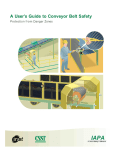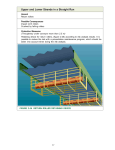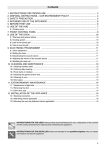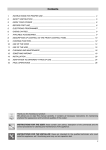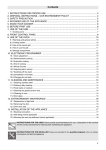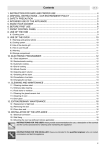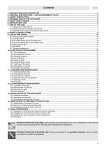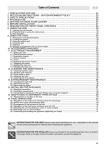Download Smeg TPKTR
Transcript
Contents 1.1 1.2 1.3 1.4 1.5 1.6 General safety instructions Manufacturer liability Purpose of the accessory Disposal This user manual How to read the user manual 2 Description 2.1 Teppanyaki plate 2.2 Scraper 3 Use 3.1 Instructions 3.2 First use 3.3 Using the Teppanyaki plate 4 Cleaning 4.1 Instructions 4.2 Cleaning the accessory 10 10 10 10 10 11 11 EN 1 Instructions 12 12 12 13 13 13 13 14 14 14 We advise you to read this manual carefully, which contains all the instructions for maintaining the appliance's aesthetic and functional qualities. For further information on the product: www.smeg.com 9 Instructions 1 Instructions 1.1 General safety instructions Risk of personal injury • This accessory gets very hot during use. • Keep children under eight years of age at a safe distance if they are not constantly supervised. • Children must never play with the accessory. • Never rest metallic objects such as knives, forks, spoons and lids on the accessory during use. • The appliance must never be cleaned by unsupervised children. Damage to the accessory • Use wooden or plastic utensils. • Do not use steam jets for cleaning the accessory. • Never leave the accessory unattended during cooking operations where fats or oils could be released. 10 1.2 Manufacturer liability The manufacturer declines all liability for damage to persons or property caused by: • use of the accessory for purposes other than those envisaged; • non-observance of the user manual provisions; • tampering with any part of the accessory. 1.3 Purpose of the accessory • This accessory is intended for cooking food in the home environment. Every other use is considered improper. • This accessory may be used by children aged at least 8 and by people of reduced physical and mental capacity, or lacking in experience in the use of electrical appliances, as long they are supervised or instructed by adults who are responsible for their safety. • The accessory is not designed to operate with external timers or with remote-control systems. 1.4 Disposal This accessory must be disposed of separately from other waste (Directives 2002/95/EC, 2002/ 96/EC, 2003/108/EC). The accessory does not contain substances in quantities sufficient to be considered hazardous to health and the environment, in accordance with current European directives. Instructions Plastic packaging Danger of suffocation • Do not leave the packaging or any part of it unattended. • Do not let children play with the packaging plastic bags. 1.6 How to read the user manual This user manual uses the following reading conventions: Instructions General information on this user manual, on safety and final disposal. Description EN Disposing of the accessory: • Consign the accessory to the appropriate selective collection centres for electrical and electronic equipment waste, or deliver it back to the retailer when purchasing an equivalent product, on a one for one basis. Our products are packed in non-polluting and recyclable materials. • Consign the packing materials to the appropriate selective collection centres. Description of the accessory and its accessories. Use Information on the use of the accessory and its accessories, cooking advice. Cleaning Information on correct cleaning of the accessory. 1.5 This user manual This user manual is an integral part of the accessory and must therefore be kept in its entirety and in an accessible place for the whole working life of the accessory. Read this user manual carefully before using the accessory. Safety instructions Information Advice 1. Use instruction sequence. • Single use instruction. 11 Description 2 Description 2.1 Teppanyaki plate Useful for cooking meat, fish and vegetables directly on the plate without adding fats or oils, staying true to the tradition of Japanese cuisine that seeks to 2.2 Scraper Useful for cleaning the Teppanyaki plate. Do not use on other surfaces. The accessories intended to come into contact with food are made of materials that comply with the provisions of current legislation. 12 exalt the natural flavours and aromas of food ensuring light nourishment while preserving all nutritional elements. Use 3 Use 3.3 Using the Teppanyaki plate High temperatures during use Danger of burns • Protect your hands using heat resistant gloves when moving food. • Do not pour water onto the hot plate. • Oils and fat could catch fire if overheated. Be very careful. Improper use Risk of damage to surfaces • It is not possible to use more than one plate at the same time on the same appliance. • The Teppanyaki plate should be positioned in place of the grid. • The appliance the Teppanyaki plate is to be used on must be fitted with rear top skirtboard or steel panel. Improper use Risk of damage to surfaces • The Teppanyaki plate should be placed inside the perimeter of the hob. • The Teppanyaki plate must not be used for more than 60 minutes. • The burners under the plate can be lit at the same time to the maximum setting for no more than 10 minutes. After this time they should be set at the minimum setting. 3.2 First use 1. Remove any protective film from the outside or inside of the appliance, including accessories. 2. Remove any labels from the plate and accessories. 3. Rinse, dry and lightly oil the Teppanyaki plate. 13 EN 3.1 Instructions Use Cleaning 4 Cleaning 4.1 Instructions Improper use Risk of damage to surfaces • The burners under the plate can be lit at the same time to the maximum setting for no more than 10 minutes. After this time they should be set at the minimum setting. The Teppanyaki plate must not, in any case, be used for more than 60 minutes. • After use, the burners must be turned off and left to cool for at least 60 minutes. The oven or ovens in the appliance on which the plate is used can be used together with the plate for a maximum of 60 minutes, while also following the indications provided in the instruction booklet. • The same precautions should be followed even if only one burner is being used. • After use, wait at least 15 minutes before removing the plate from the appliance. 14 • Do not use steam jets for cleaning the appliance. • Do not use cleaning products containing chlorine, ammonia or bleach on steel parts or parts with metallic finishes on the surface (e.g. anodizing, nickel- or chromium-plating). • Do not use rough or abrasive materials • Never wash in the dishwasher. 4.2 Cleaning the accessory The Teppanyaki plate is easier to clean when it is still lukewarm. • Use conventional specific detergents for stainless steel and non-abrasive sponges. Any remaining encrustations or food residues can be easily removed by soaking the plate for a while. For very stubborn encrustations, we recommend using the supplied scraper. Dry it carefully. Do not soak the plate in water immediately after use. Wait for it to cool down.








